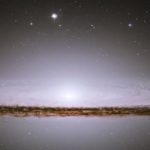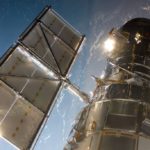The 'Hubble': 27 years revealing the mysteries of the cosmos
The Sombrero Galaxy presents a mystery to astronomers, who haven’t been able to explain all the details of this intriguing formation. Rings of dust hold bright young stars and right in the middle of the impressive sombrero is a giant black hole. The 50 year-old light from this galaxy, which is lost in the Virgo constellation, reaches Earth thanks to the Hubble Space Telescope, which turns 27 years old today.

The powerful cameras of its system send dreamlike, almost magical images to our planet. However, the scientific value of the photographs the Hubble sends to experts are far from fantasy. Scientists have been able to understand the cosmos better, thanks to information from the telescope.
The mission began in 1990, when Hubble became the first telescope to be placed in orbit. Since then, it has provided information on the solar system, helped to discover moons around Pluto and offered hints about the formation of planets and galaxies trillions of kilometers away.
Located 538 km above sea level, the Hubble has a privileged position that accounts for its importance. NASA explains that a planet’s atmosphere, which is a mixture of gases, blocks and alters light from space, meaning that photos taken by telescopes on Earth are sometimes distorted. As the Hubble is beyond the limits of the atmosphere, it can take pictures of the universe unlike any that have been seen before.

Hubble space telescope - NASA
The images from the camera, which takes 95 minutes to circle the Earth, have been a revelation for experts, but the road has not been easy. The result of joint efforts by NASA and the European Space Agency, the project was delayed for nearly two decades. It was scheduled to start in 1983. And it was not all good news once the Hubble was in space – quite the opposite, in fact.
When the telescope started to send its first images to Earth, NASA experts were astounded to see that they were blurry; two years later, they send a team to repair it. Astronauts have made a total of five trips to space to fix the telescope and add new pieces, most recently in 2015.
The Hubble’s flashes continue to capture landscapes dominated by an intense red, bright rings, unexpected shapes, spirals and galactic collisions. But soon it won’t be alone. NASA has been working on James Webb’s construction of another space telescope that will be launched into space in 2018, when it will orbit around the sun to continue deciphering an unknown part of the universe.